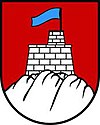Kozica
| Kozica | |||
|---|---|---|---|
| Village | |||

A sign at the entrance to Kozica
|
|||
|
|||
| Coordinates: 43°15′42″N 17°13′01″E / 43.261691°N 17.217076°ECoordinates: 43°15′42″N 17°13′01″E / 43.261691°N 17.217076°E | |||
| Elevation | 350 m (1,150 ft) | ||
| Population (2011) | |||
| • Total | 56 | ||
| Time zone | CET (UTC+1) | ||
| • Summer (DST) | CEST (UTC+2) | ||
| Postal Code | 21274 | ||
| Area code | 021 | ||
| Licence plate | MA | ||
| Climate | Cfa | ||
Kozica (Italian: Cozizza) is a small village in the Split-Dalmatia County of Croatia. It is in the jurisdiction of Vrgorac, 80 km (50 mi) southeast of Split. It lies just below Sveti Mihovil mountain, which is 1,247 m (4,091 ft) high.
Kozica was first mentioned in documents of the Kreševskoj era in 1434.
When Vrgorac capitulated to the Ottoman Empire, Kozica probably fell with the rest of the area. The spread of Islam into the region that came with the arrival of the Ottoman army concerned the occupants of the monastery in Makarska, who began to worry about the residents in Kozica and the surrounding region, fearing that many would convert to Islam.
After the liberation of inner Dalmatia from the Ottoman Empire, most of Kozica and the surrounding villages had been deserted because of the exodus of the populace to the northern regions of Croatia. The Venetian Republic repopulated the area with Herzegovinian people from the east.
The withdrawal of the Ottomans saw the region come under the jurisdiction of the Venetian Republic, then under the rule of Napoleon. A short and prosperous period followed, which included the construction of the "napoleonsku cestu" (Napoleon's road), encouraging travel to the area. With the failure of Napoleon's campaign in Dalmatia, Kozica fell under the rule of Austria-Hungary, and remained so until the end of the First World War.
Many of Kozica's population bought land near Vrgorac, where they grew their own produce, including olives and grapes; the area acquired a reputation for good wine. The Second World War changed this for the worse.
Hitler occupied Yugoslavia from April 1941; he carved the country up using different Axis armies. Kozica and the surrounding region was occupied by the Italians. With their forces operating a garrison in Kozica, it was able to keep the village and surroundings under observation. However, a rapidly growing force, Tito's partisans, was operating in the area.
...
Wikipedia



